Re-staking redefines blockchain security.
Author: Ingeun
Translated by: Deep Tide TechFlow
Key Points
Re-staking is a mechanism that allows users to use already staked assets across multiple blockchain networks or applications to provide additional security. In this way, users can reuse existing staked assets, enhancing the system's scalability and liquidity while earning additional rewards.
The re-staking stack is a conceptual framework that systematically divides the main components of the re-staking ecosystem, including the underlying blockchain networks, staking infrastructure, staking platforms, re-staking infrastructure, re-staking platforms, and re-staking applications.
Re-staking infrastructure provides the technical foundation for implementing re-staking, allowing staked assets to be used to secure other protocols or networks. Notable projects in this field include EigenLayer on Ethereum, Babylon on Bitcoin, and Solayer on Solana. These projects focus on ensuring liquidity, enhancing security, and improving network scalability.
Re-staking redefines blockchain security and has rapidly evolved into an ecosystem. Its ability to enhance scalability and liquidity through economic security makes it highly attractive, despite ongoing concerns about the risks and profitability of re-staking models.
The next part of this series will explore re-staking platforms and applications, which are crucial for the potential large-scale adoption of the re-staking ecosystem.
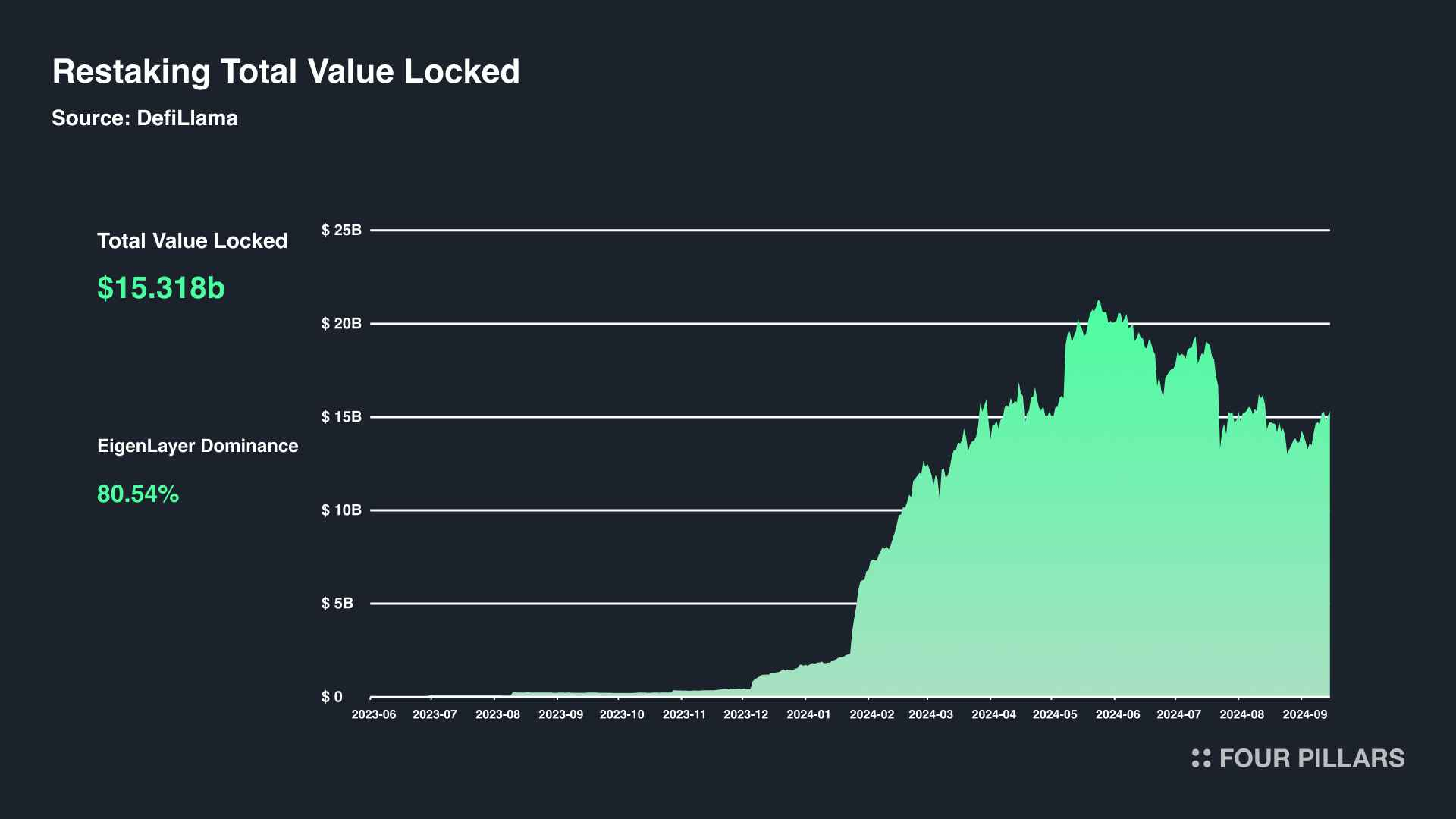
As of September 28, 2024, the total locked value (TVL) of the re-staking ecosystem led by EigenLayer is approximately $15.3 billion. This figure surpasses the $13 billion TVL of the crypto lending platform Aave and is more than half of the TVL of the leading Ethereum liquid staking platform Lido ($26.48 billion). This highlights the significant growth of the re-staking ecosystem.
Given this, you may wonder what re-staking is, why it has attracted the interest of crypto holders, and what has driven such growth. To answer this question, this two-part series will explain what re-staking is, from which perspectives to view the expanding re-staking ecosystem, and the interesting projects within it.
This series will start with an overview of re-staking, define the re-staking stack around a robust re-staking infrastructure, and explore projects classified as re-staking infrastructure and their unique features.
1. Overview of Re-staking
1.1 Before Re-staking
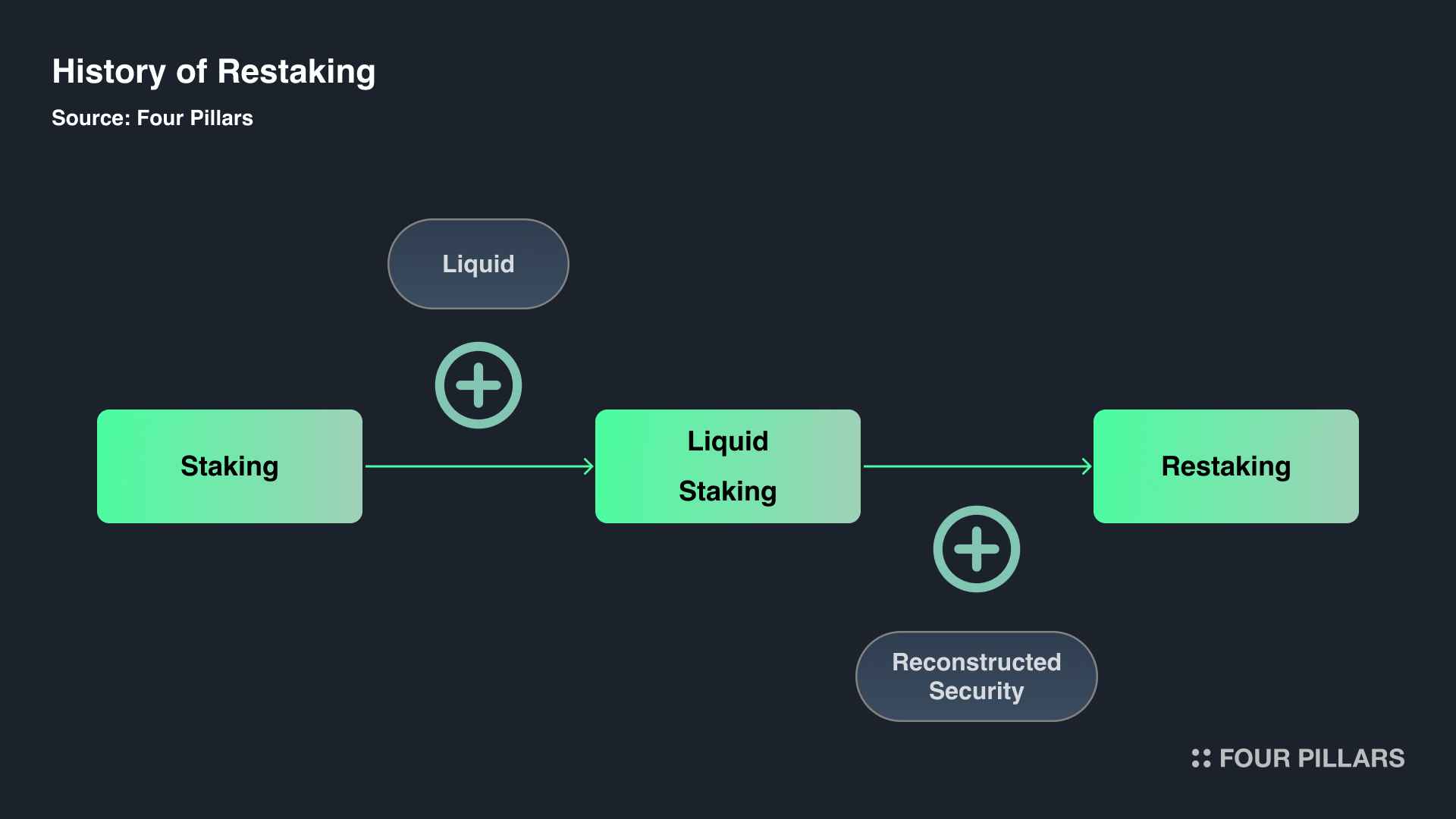
When Ethereum transitioned from proof of work (PoW) to proof of stake (PoS) through the highly anticipated "Merge" upgrade, many ETH holders began staking their ETH to support network stability and earn staking rewards. This process gave rise to various staking services and platforms.
The first demand that emerged was for staking pools. The minimum requirement of 32 ETH for staking posed a significant challenge for smaller Ethereum holders. To address this issue, staking pools were developed, allowing those with less than 32 ETH to participate in Ethereum staking.
The next challenge was liquidity. When ETH is staked, the assets are locked in smart contracts, leading to reduced liquidity. In the initial phase of the PoS transition, staked ETH could not even be withdrawn, effectively meaning that staked ETH had almost no liquidity. To solve this problem, services like Lido and Rocket Pool issued liquid staking tokens (LSTs). The value of LSTs is pegged to the staked ETH, allowing stakers to use them as substitutes for their staked ETH in other DeFi services. In effect, LSTs enable users to regain some liquidity of their staked assets.
After ensuring liquidity through LSTs, new opportunities arose for utilizing these tokens. However, LSTs were primarily confined to the Ethereum DeFi ecosystem and were not used to secure Layer 2 (L2) networks built on Ethereum. This presented new challenges for Ethereum's security model, such as:
Scalability Issues: Ethereum's limited transaction processing capacity means that during periods of high demand, the network can become congested, leading to significantly increased transaction fees. This makes it difficult for dApps and DeFi platforms to handle large numbers of users. Layer 2 (L2) solutions emerged to address this issue, but they require their own security and validation mechanisms.
Additional Security Needs: The fundamental security mechanisms of Ethereum operate at the protocol level and rely on participants staking ETH to maintain network security. However, these built-in security measures do not always meet the specific security needs of various L2s and applications, necessitating an additional layer of security for each application.
Liquidity Constraints: While Ethereum activated the staking mechanism through PoS, a key issue remains: staked assets are only used for network security. For example, staked ETH cannot be used for other useful functions or applications. This limits liquidity and hinders network participants' ability to explore additional revenue opportunities.
These challenges highlight the need for a new security mechanism tailored to the current state of Ethereum and PoS blockchains.
1.2 The Rise of Re-staking
The demand for new security methods ultimately gave rise to the concept of re-staking.
“Re-staking is the latest answer to the core security question in the crypto space: how to use economic games to secure decentralized computing systems.” — Sam Kessler, CoinDesk
As the quote suggests, re-staking leverages principles of financial engineering to enhance the security of blockchains through economic security.
Before delving deeper into re-staking, it is important to understand how PoS blockchains maintain security. Many blockchains, including Ethereum, adopt PoS, where a common attack method is for adversaries to accumulate enough staked assets to influence the network. The cost of compromising the blockchain is typically proportional to the total value staked in the network, which serves as a deterrent to attackers.
Re-staking further develops this concept, aiming to apply economic security more broadly. In major protocols like Ethereum, a significant amount of capital has already been staked. Re-staking reuses this capital to provide enhanced security and functionality at the L2 or application level. With increased security, re-stakers can earn higher returns than traditional staking. Thus, re-staking becomes a solution to the challenges mentioned above:
Scalability: Re-staking allows L2 solutions and other applications to leverage the security of the main blockchain's staked resources. This enables L2 solutions to maintain a higher level of security without building independent mechanisms.
Enhanced Security: Re-staking allows the staked resources of the main blockchain to be used not only to secure the main network but also to validate and protect application-level functionalities. This creates a more robust and comprehensive security framework.
Increased Liquidity: Re-staking aims to make staked mainnet assets reusable for other purposes. For example, staked assets can be used for validation tasks in different networks or applications, thereby increasing the overall liquidity and utility of the security ecosystem while providing additional rewards to participants.
In summary, re-staking emerged as a response to the limitations of PoS mainnets like Ethereum, aiming to enable these networks to support more participants while providing higher security and liquidity.
A notable early implementation of the re-staking concept is Interchain Security (ICS). Cosmos operates an ecosystem where multiple independent blockchains interact through cross-chain concepts. However, each chain needs to maintain its own security, which creates a burden. ICS addresses this issue by allowing blockchains within the Cosmos ecosystem to share security resources.
Validators of the Cosmos Hub are responsible for securing the network, and new or smaller chains can leverage this security without needing to establish their own validator networks. This approach reduces security costs and helps new blockchain projects launch more easily within the Cosmos ecosystem. However, challenges such as increased infrastructure costs, limited utility of native tokens, and consumer chains' demand for high profitability have constrained the success of ICS.
Nevertheless, these efforts paved the way for EigenLayer in the Ethereum ecosystem, which has become a leader in the re-staking industry. Therefore, to thoroughly understand re-staking, studying EigenLayer, which is already established in the Ethereum ecosystem, is a great starting point. Let’s delve into EigenLayer and the re-staking ecosystem.
1.3 Example Through EigenLayer
1.3.1 From Decentralized Security to Reconstructed Security
How does re-staking fundamentally operate to provide stronger security and liquidity?
“If I have seen further, it is by standing on the shoulders of giants.” — Isaac Newton
This quote from Isaac Newton acknowledges the contributions of past scientists to his achievements. More broadly, it suggests that leveraging existing resources is often a wise choice.
Many current blockchain services rely on large Layer 1 (L1) networks, utilizing their ecosystems, trust, and security resources. However, choosing a less mature network or attempting to independently become a major player can be risky, as these projects may encounter setbacks before reaching their full potential.
To illustrate this through EigenLayer, let’s consider the scenario depicted in the following diagram.

In the diagram, both ecosystems have $13 billion in staked capital. On the left, Ethereum and Active Validation Services (AVS, a middleware network service) are not interconnected, while on the right, they are connected through EigenLayer.
Left Ecosystem: Here, Ethereum and AVS are not directly connected, so while value can be transferred between networks via bridging, this does not relate to shared security. As a result, Ethereum and AVS cannot share economic security, leading to a decentralization of security. Attackers may choose to target the network with the least staked capital. This results in a decentralization of security, where the cost of corruption (CoC) aligns with the minimum required amount. This situation creates a competitive environment between services rather than a synergy, which could undermine Ethereum's economic security.
Right Ecosystem: What if Ethereum and AVS were interconnected? EigenLayer integrates Ethereum and AVS through the concept of re-staking, merging decentralized security into a reconstructed form. This integration has two benefits: AVS services can share the capital of the Ethereum network instead of competing with it, allowing all AVS services to fully utilize shared economic security. This effectively creates an environment where these "giants" combine their strengths, enabling them to see further together.
1.3.2 Pillars of Re-staking (Using EigenLayer as an Example)
Through this explanation, we can understand that AVS services can inherit Ethereum's economic security, allowing them to leverage significant security at a lower cost. However, this complex financial ecosystem relies on various roles to operate smoothly. Let’s delve into these roles:
Active Validation Services (AVS): AVS are services that require a decentralized validation system, such as DA layers, sidechains, or oracle networks. AVS relies on node operators to maintain network security by reliably running nodes. AVS employs two mechanisms: slashing, where part or all of the staked amount is forfeited due to underperformance, and rewards for successful operations. AVS can leverage Ethereum's security by utilizing re-staked ETH without needing to establish a separate trust network.
Re-stakers: Re-stakers are individuals or institutions that re-stake local ETH or LST on the Ethereum beacon chain. If re-stakers are uncertain about which specific AVS to choose or wish to earn additional rewards, they can delegate their re-staked capital to node operators. In this case, re-stakers hand over their capital to be managed by the nodes operated by the node operators, thereby earning re-staking rewards.
Node Operators: Node operators receive the capital delegated by re-stakers and operate nodes to perform the validation tasks required by AVS. Node operators utilize the re-staked capital to establish and run nodes with higher security. They play a crucial role in maintaining the reliability and security of AVS and thus earn rewards for re-staking and node operation.
1.3.3 Merging into One
EigenLayer integrates these roles into an open market structure, allowing each role to operate freely based on economic principles.
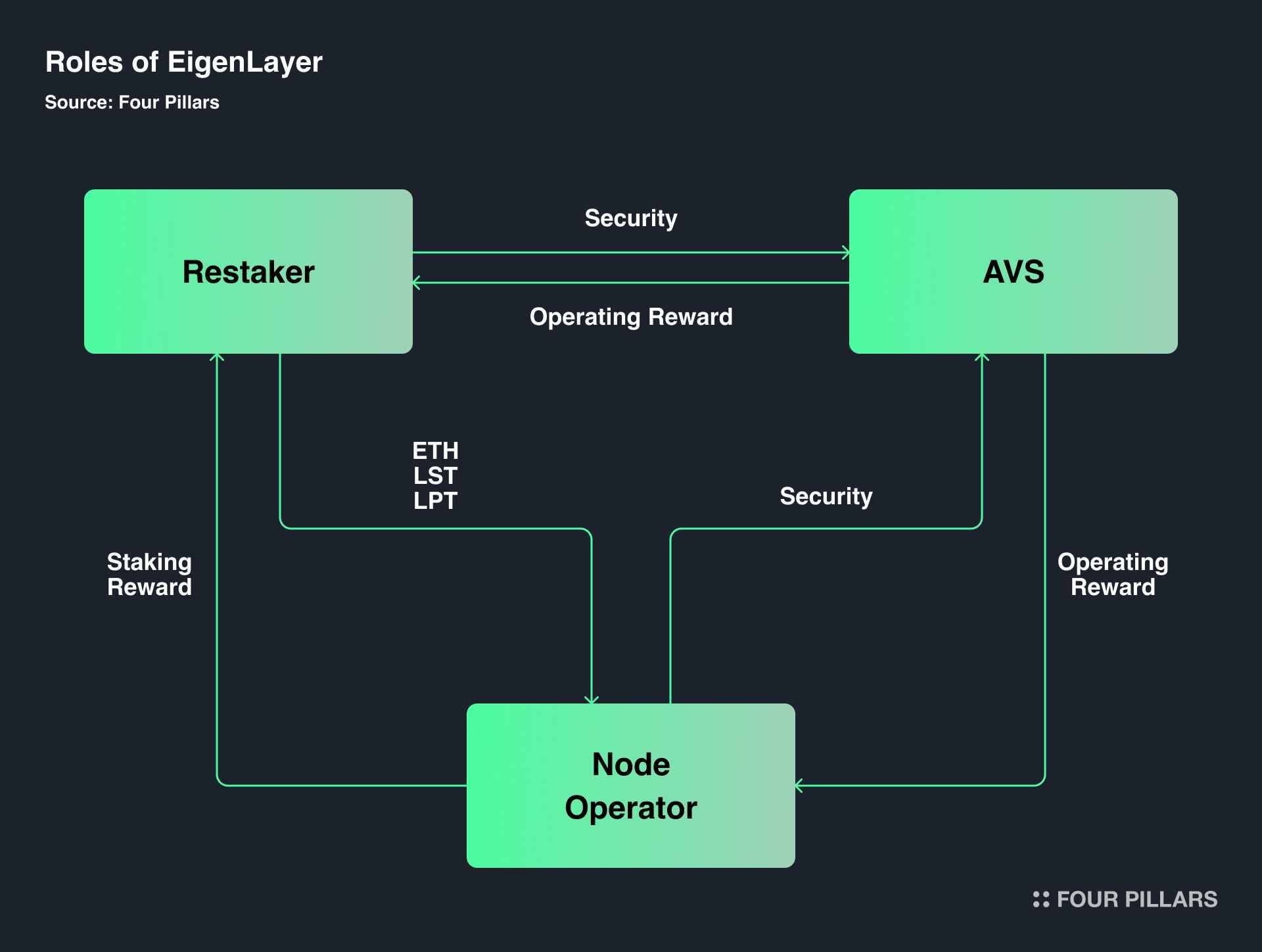
In this setup, re-stakers delegate their assets (such as ETH, LST, or LPT) to node operators, who then protect AVS services through their nodes and earn rewards. At the same time, AVS pays operational rewards to node operators in appreciation of their contributions to security, thereby ensuring the safety and trust of the network.
1.3.4 Strengthening the Re-staking Ecosystem
EigenLayer is a typical example of re-staking, providing a comprehensive perspective on this concept. Most emerging re-staking services strictly adhere to the core principles of re-staking, making EigenLayer an effective reference for understanding re-staking models.
As EigenLayer is at the forefront, the re-staking ecosystem is expanding. This growth is not only reflected in scale; the ecosystem is becoming increasingly complex, with more specific roles and classifications emerging. This allows for a deeper understanding of the continuously expanding ecosystem. In the next chapter, we will take a closer look at the re-staking stack and explore projects within each category.
2. The Re-staking Stack
As the re-staking ecosystem is still actively developing, clearly delineating each category can be challenging. However, as the ecosystem matures and positioning stabilizes, it will facilitate the development of more advanced projects. Utilizing available data and my perspective, I will introduce a framework for classifying the re-staking ecosystem—the re-staking stack.

2.1 Blockchain Network-Based

The blockchain network layer serves as the foundation for staking or re-staking, possessing its own native tokens and security mechanisms. PoS (Proof of Stake) blockchains like Ethereum and Solana, due to their substantial TVL (Total Value Locked), provide a stable and efficient environment for staking and re-staking. Although Bitcoin is not a PoS blockchain, efforts have been made to incorporate its economic security into re-staking due to its dominant position in blockchain capital.
Ethereum: Ethereum is the primary blockchain network for re-staking, playing a key role in the entire ecosystem. With its PoS system and smart contract capabilities, Ethereum offers users the opportunity to participate in various re-staking activities through platforms like EigenLayer.
Bitcoin: Bitcoin lacks the native staking capabilities of PoS blockchains due to its PoW (Proof of Work) mechanism. However, projects like Babylon are dedicated to integrating Bitcoin's vast capital into the re-staking ecosystem, leveraging its economic security to support other blockchains. Projects like Babylon allow the use of Bitcoin's capital without the need for wrapping or cross-chain bridging, enabling Bitcoin staking directly on their blockchain.
Solana: Solana is known for its high performance and low transaction costs, providing an ideal environment for staking, DeFi, NFTs, and re-staking. As Solana's staking infrastructure continues to evolve, platforms like Solayer are emerging, aiming to leverage Solana's advantages through unique re-staking models, establishing a significant position for Solana in the re-staking ecosystem.
2.2 Staking Infrastructure

The staking infrastructure layer includes systems that allow participants to stake their native tokens, thereby enhancing the security and efficiency of the blockchain network. This infrastructure is central to the PoS consensus mechanism, supporting the decentralized processes of block validation and generation. Participants stake their assets to become validators, helping to maintain network stability and earn rewards. Additionally, the staking infrastructure is responsible for monitoring validator behavior, enhancing security through slashing penalties for misconduct.
Beacon Chain: The beacon chain plays a critical role in Ethereum's transition to PoS, enhancing scalability, security, and energy efficiency. Unlike the previous PoW Ethereum, the beacon chain operates around validators staking local ETH. The beacon chain is responsible for selecting validators and managing the proposal and validation of blocks. This transition reduces the high energy consumption of PoW mining while maintaining the decentralization of the network and improving efficiency. Furthermore, the beacon chain supervises users participating in validation, locking their staked local ETH and monitoring whether validators correctly validate blocks. If validators misbehave, they face penalties through the slashing process, which involves confiscating their staked ETH.
Staking Pools: Solana's staking pools enhance network security and simplify the process for users to participate in staking. Staking pools aggregate smaller SOL stakes, allowing users to collectively support a single validator. Through this process, users who delegate their stakes to validators earn rewards when these validators create blocks or validate transactions. Staking pools also improve network stability by allocating staked SOL to reliable validators.
2.3 Staking Platforms

The staking platform layer includes various services that enable users to contribute to the security and operation of blockchain networks while maintaining the liquidity of their assets. These platforms play a crucial role in PoS blockchains, providing simple services that allow users to stake native tokens and earn rewards. Staking platforms are not just about locking assets; they also offer liquid staking, tokenizing staked assets so that users can utilize these assets in DeFi services. This structure allows users to maintain liquidity while participating in network operations and maximizing rewards. Through these features, staking platforms simplify the user experience, making it easier for more users to participate in staking.
Lido: Lido is one of the most popular liquid staking platforms in the Ethereum ecosystem, allowing users to stake their native ETH and receive stETH in return. This liquid token maintains the value of staked ETH, enabling users to earn additional rewards through other DeFi services. Lido's focus on Ethereum has since expanded to support Polygon's PoS network.
Rocket Pool: Rocket Pool is a community-owned decentralized staking platform compatible with native ETH staking on Ethereum. Originally conceived in 2016 and launched in 2021, it aims to provide a solution for users who lack the technical ability to run nodes or the financial means to meet the 32 ETH requirement. Rocket Pool is committed to building a liquid and reliable platform that allows users to leverage their staked assets across various services.
Jito: Jito is a liquid staking platform that provides MEV (Maximum Extractable Value) rewards for Solana users. Users stake their native SOL through Jito's staking pools and receive JitoSOL tokens, which accumulate staking and MEV rewards while maintaining liquidity. Jito aims to optimize returns for users holding JitoSOL, enriching Solana's DeFi ecosystem.
Sanctum: Sanctum leverages Solana's high speed and low fees to provide enhanced security as a staking platform through an open-source and multi-signature framework. It allows users to utilize staked SOL in DeFi services. By integrating the liquidity of various LST pools, it addresses the issue of liquidity fragmentation, enabling users to access richer liquidity pools. Notably, through the Infinity Pool, users can deposit LST or SOL to receive INF tokens, simplifying staking and liquidity provision. Additionally, Sanctum runs a rewards program called Wonderland, encouraging user participation by providing points and rewards for completing specific tasks or using the platform.
2.4 Re-staking Infrastructure

The re-staking infrastructure layer is crucial for enhancing the economic security of blockchain networks while providing scalability and flexibility. It enables users to reuse their staked assets to secure multiple networks or applications, offering re-stakers opportunities to participate in various services while maximizing rewards. Applications built on this infrastructure can ensure a more robust security framework and expand their functionalities by leveraging re-staked assets. The re-staking infrastructure also supports re-staking platforms and applications, allowing them to create customized staking and security models. This enhances the scalability and interoperability of the blockchain ecosystem, making re-staking a key technology for maintaining decentralized networks. Here are some examples, with more details about re-staking infrastructure provided in Chapter 3.
EigenLayer: EigenLayer is a re-staking infrastructure built on Ethereum that allows users to re-stake their native ETH or LSTs to secure additional applications and earn extra rewards. By reusing staked ETH across various services, EigenLayer lowers the capital requirements for participation while significantly enhancing the credibility of individual services.
Symbiotic: Symbiotic is a re-staking infrastructure that provides an open and accessible shared security model for decentralized networks. It enables builders to create customized staking and re-staking systems with modular scalability and decentralized operator rewards and slashing mechanisms, providing enhanced economic stability for the network.
Babylon: Babylon connects Bitcoin's robust economic security to other blockchains, such as Cosmos, aiming to strengthen security and facilitate cross-chain interoperability. Babylon's integration allows networks connected through it to leverage Bitcoin's proven security for safer transactions. It utilizes Bitcoin's computational power to enhance finality and provides a set of protocols to securely share Bitcoin's security with other networks.
Solayer: Solayer extends application chains by leveraging economic security built on the Solana network, providing application developers with customized block space and efficient transaction alignment. It utilizes re-staked SOL and LSTs to maintain network security while enhancing specific network functionalities, aiming to support scalable application development.
2.5 Re-staking Platforms

The re-staking platform layer includes those that provide additional liquidity or combine re-staked assets with other DeFi services, enabling users to maximize their rewards. These platforms often issue liquidity re-staking tokens (LRTs) to further enhance the liquidity of re-staked assets. They also promote user participation in re-staking through flexible management models and reward systems, contributing to the stability and decentralization of the re-staking ecosystem.
Ether.fi: Ether.fi is a decentralized re-staking platform that allows users to directly control their re-staking keys. It provides a service marketplace where node operators and re-stakers interact. The platform issues eETH as a liquid staking token and achieves decentralization of the Ethereum network through a multi-step re-staking process and node service provision.
Puffer.fi: Puffer.fi is a decentralized native liquid re-staking platform based on EigenLayer. It allows anyone with less than 32 ETH to stake their native Ethereum tokens, maximizing rewards through integration with EigenLayer. Puffer.fi offers high capital efficiency, providing liquidity and PoS rewards through its pufETH token. Re-stakers can earn stable returns without needing complex DeFi strategies, and Puffer.fi's security mechanisms ensure asset safety.
Bedrock: Bedrock supports multiple asset types in its liquid re-staking platform, developed in collaboration with RockX. It provides additional rewards by re-staking assets such as wBTC, ETH, and IOTX. For example, uniBTC re-stakes BTC on the Ethereum network to enhance security, while uniETH similarly re-stakes ETH, maximizing rewards through EigenLayer. Bedrock adopts a capped token economic structure to prevent total issuance growth, aiming to increase token value over time.
Fragmetric: Fragmetric is a liquid re-staking platform in the Solana ecosystem that addresses reward distribution and slashing rate issues by leveraging Solana's token expansion capabilities. Its fragSOL token sets a new standard for re-staking on Solana, providing a platform structure that enhances security and profitability.
2.6 Re-staking Applications

The re-staking application layer includes decentralized services and applications that utilize re-staked assets to enhance the security and functionality of existing blockchain infrastructure. These applications ensure economic security through re-staking while focusing on providing specific functionalities, such as data availability storage, oracles, physical infrastructure verification, and cross-chain interoperability.
By allowing validators on Ethereum and other blockchain networks to re-stake their assets across multiple services, these applications lower capital costs while improving security and scalability. They also ensure data integrity and security through decentralized processes and apply economic incentives and penalties to ensure reliability. These applications enhance the scalability and efficiency of blockchain systems and promote interoperability between different services.
EigenDA: EigenDA is a highly scalable data availability (DA) storage solution for Ethereum rollups, integrated with EigenLayer. EigenLayer requires operators to stake collateral to participate and penalizes operators who fail to correctly store and verify data. This incentivizes decentralized and secure data storage while enhancing EigenDA's scalability and security through EigenLayer's re-staking mechanism.
Eoracle: Eoracle is an oracle service within the EigenLayer ecosystem that utilizes re-staked ETH and Ethereum validators for data verification. Eoracle aims to create a decentralized competitive market for data providers and users, automating data verification and enabling smart contracts to integrate external data sources.
Witness Chain: Witness Chain supports the development of new products and services for various applications and decentralized physical infrastructure networks (DePIN). It uses a DePIN coordination layer (DCL) module to convert physical attributes into verifiable digital proofs. Within the EigenLayer ecosystem, EigenLayer operators run DePIN challenge clients to ensure a reliable environment for their verification processes.
Lagrange: Lagrange is the first zero-knowledge AVS on EigenLayer. Its state committee is a decentralized network of nodes that utilizes zero-knowledge technology to ensure the security of cross-chain interoperability. Lagrange's ZK MapReduce solution supports efficient cross-chain operations while ensuring security and scalability. By leveraging EigenLayer's economic security, Lagrange enhances performance and strengthens cross-chain messaging and rollup integration.
Through an overview of the re-staking technology stack and project examples, we can see that as the re-staking ecosystem matures, its structure becomes more refined, providing a deeper understanding. Should we delve deeper into these emerging categories? In this series, we will first focus on re-staking infrastructure, while other components will be explored in subsequent sections.
3. Re-staking Infrastructure Ecosystem

The re-staking infrastructure serves as a foundational framework that allows for the reuse of staked assets across different networks and protocols to enhance network security and maximize utility. As the concept of re-staking gains traction, major blockchain networks like Ethereum, Bitcoin, and Solana have developed infrastructures tailored to their unique characteristics. In this section, we will explore the reasons for the emergence and evolution of re-staking infrastructure in these networks, the advantages and challenges they face, and the impact of various projects on re-staking infrastructure.
3.1 Ethereum
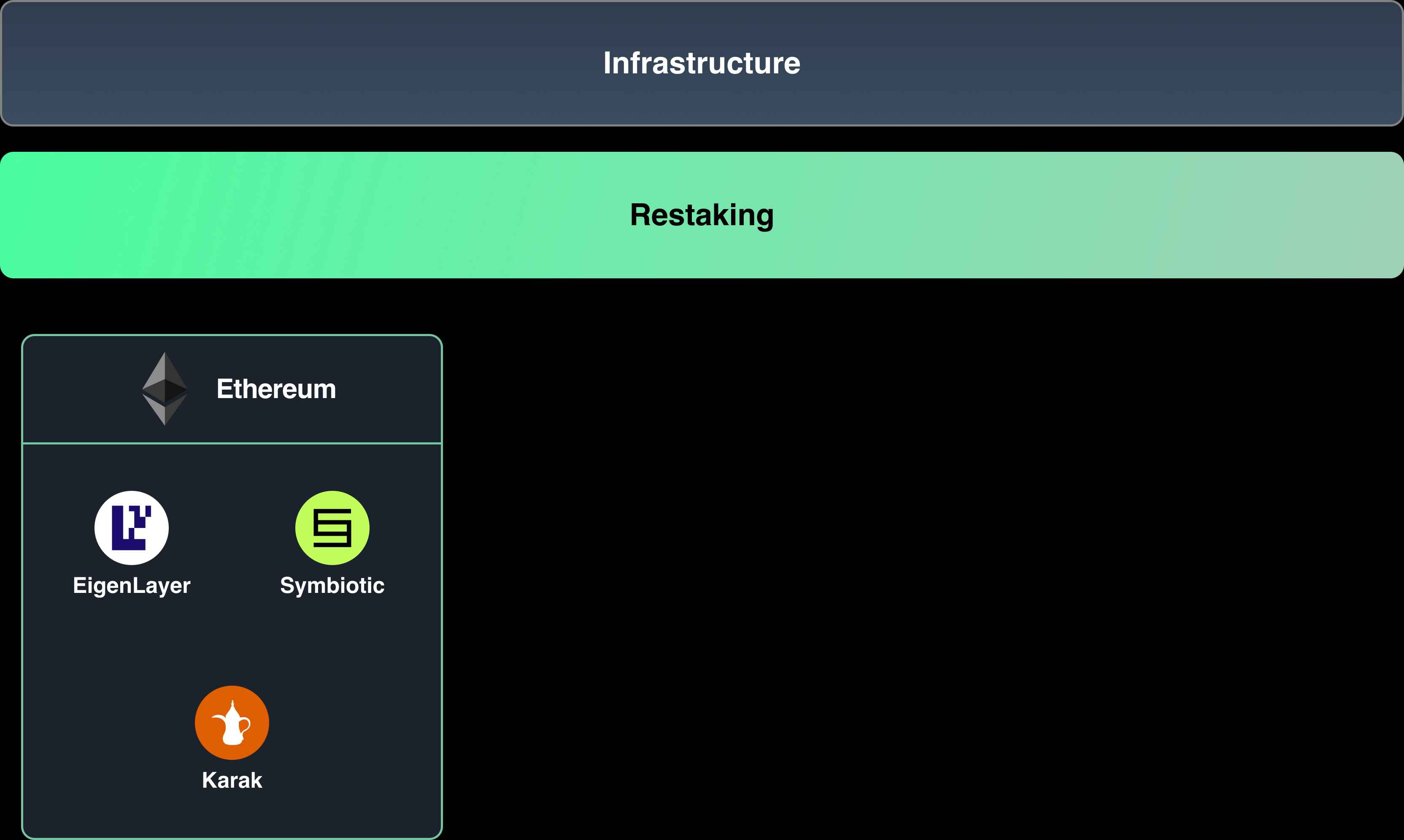
During the "Merge" upgrade, Ethereum transitioned from PoW to PoS, laying the groundwork for the growth of re-staking infrastructure. Ethereum's PoS model relies on staked assets to secure the network, but the ability to repurpose these assets for other protocols has significantly increased interest in re-staking.
Ethereum has primarily focused on scalability, achieving this through L2 solutions. However, as Ethereum founder Vitalik Buterin pointed out, this approach has led to a decentralization of security, ultimately undermining Ethereum's security model. EigenLayer, as the first solution, addresses this issue through economic security, allowing staked Ethereum assets to be used in other protocols to enhance security and scalability.
EigenLayer provides re-staked Ethereum assets across different protocols while maintaining base security and leveraging a large operator network to achieve stable economic security. It supports the re-staking of native ETH and plans to expand to LSTs and ERC-20 tokens, offering a potential solution to Ethereum's scalability challenges.
The concept of re-staking is spreading within the Ethereum ecosystem, with other projects also working to address Ethereum's limitations. For example, Symbiotic enhances Ethereum's security by integrating with other DeFi services. Symbiotic supports the re-staking of various assets, including LSTs like wstETH, as well as assets like sUSDe and ENA through collaboration with Ethena Labs. This allows users to provide additional security resources through re-staking, enhancing Ethereum's PoS security. Additionally, Symbiotic issues ERC-20 tokens like LRT to provide a flexible reward structure, allowing for efficient use of re-staked assets across various protocols.
Another re-staking infrastructure, Karak, aims to address the structural inefficiencies of Ethereum that pose challenges to re-staking operations. Karak offers multi-chain support, enabling users to deposit assets on chains like Arbitrum, Mantle, and Binance Smart Chain. It supports the re-staking of ERC-20 tokens, stablecoins, and LSTs in a multi-chain environment. Karak uses its own L2 chain to store assets, maximizing scalability while ensuring security.
3.2 Bitcoin
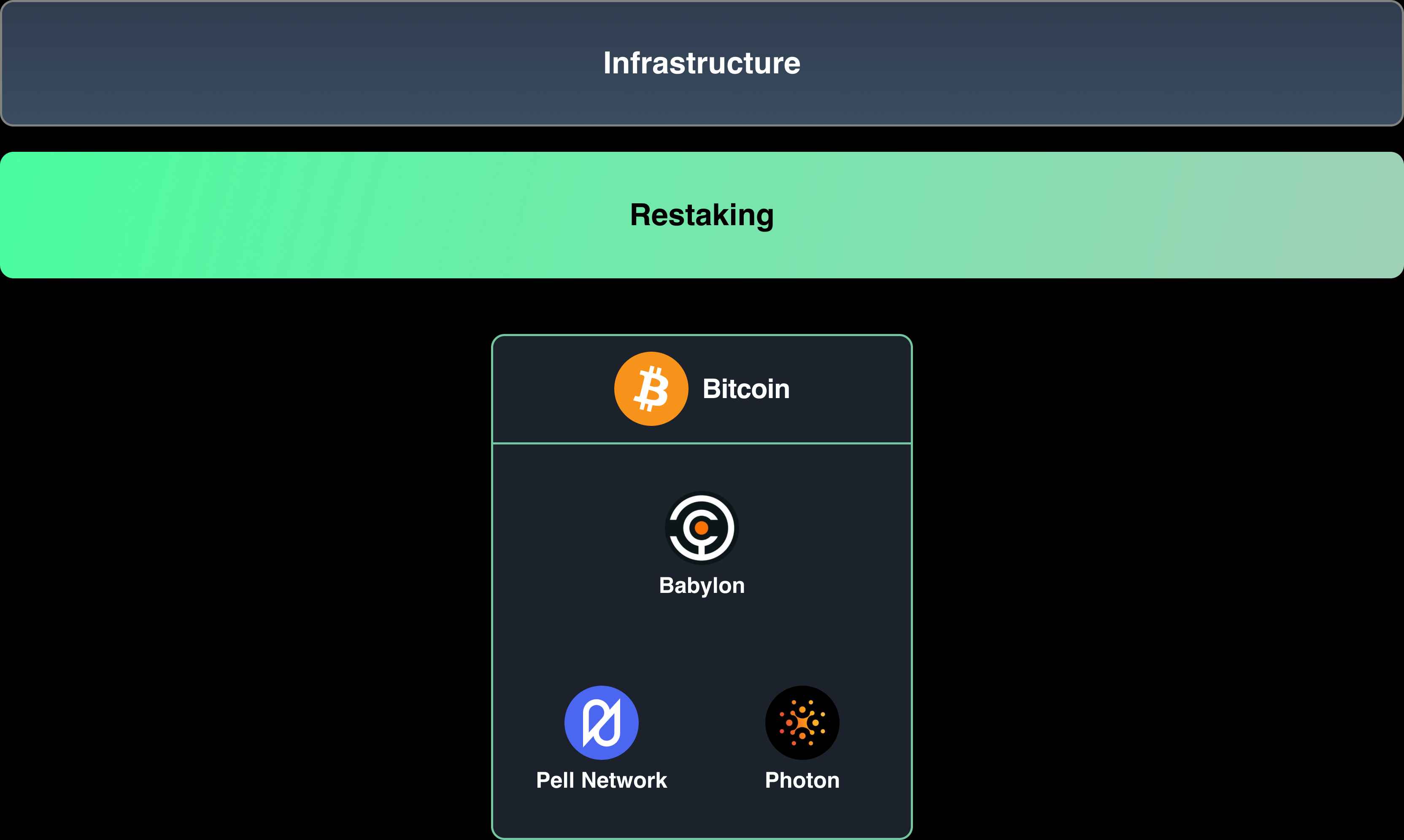
As a PoW-based network, Bitcoin's characteristics differ from PoS networks where staked assets are directly related to security. However, Bitcoin's dominance in market capitalization has driven the development of re-staking concepts that leverage Bitcoin's economic security to create additional income in other blockchains. Projects like Babylon, Pell Network, and Photon integrate Bitcoin's security into their ecosystems through various methods, thereby enhancing their scalability.
Bitcoin's PoW system is one of the most secure systems in the world, making it a valuable asset for re-staking infrastructure. Babylon enhances the security of other PoS blockchains by utilizing Bitcoin's staking and re-staking capabilities. It transforms Bitcoin's economic value into economic security, providing protection for other blockchains. It operates its own PoS chain using the Cosmos SDK, supporting non-custodial staking and re-staking directly from the Bitcoin blockchain without the need for third-party trust.
Bitcoin also faces challenges related to liquidity and additional income opportunities. The creation of Pell Network aims to provide liquidity and income opportunities for Bitcoin holders by integrating Bitcoin into the DeFi ecosystem using cross-chain technology for additional yield.
The biggest limitation of Bitcoin is the lack of native smart contract support. While PoW provides strong security, its design makes internal programming through smart contracts difficult. Photon expands Bitcoin's capabilities to execute smart contracts without altering its core structure, enabling staking and re-staking directly on the Bitcoin mainnet. This ensures that all processes related to staking and re-staking are verified on the Bitcoin mainnet while providing flexible staking options.
3.3 Solana
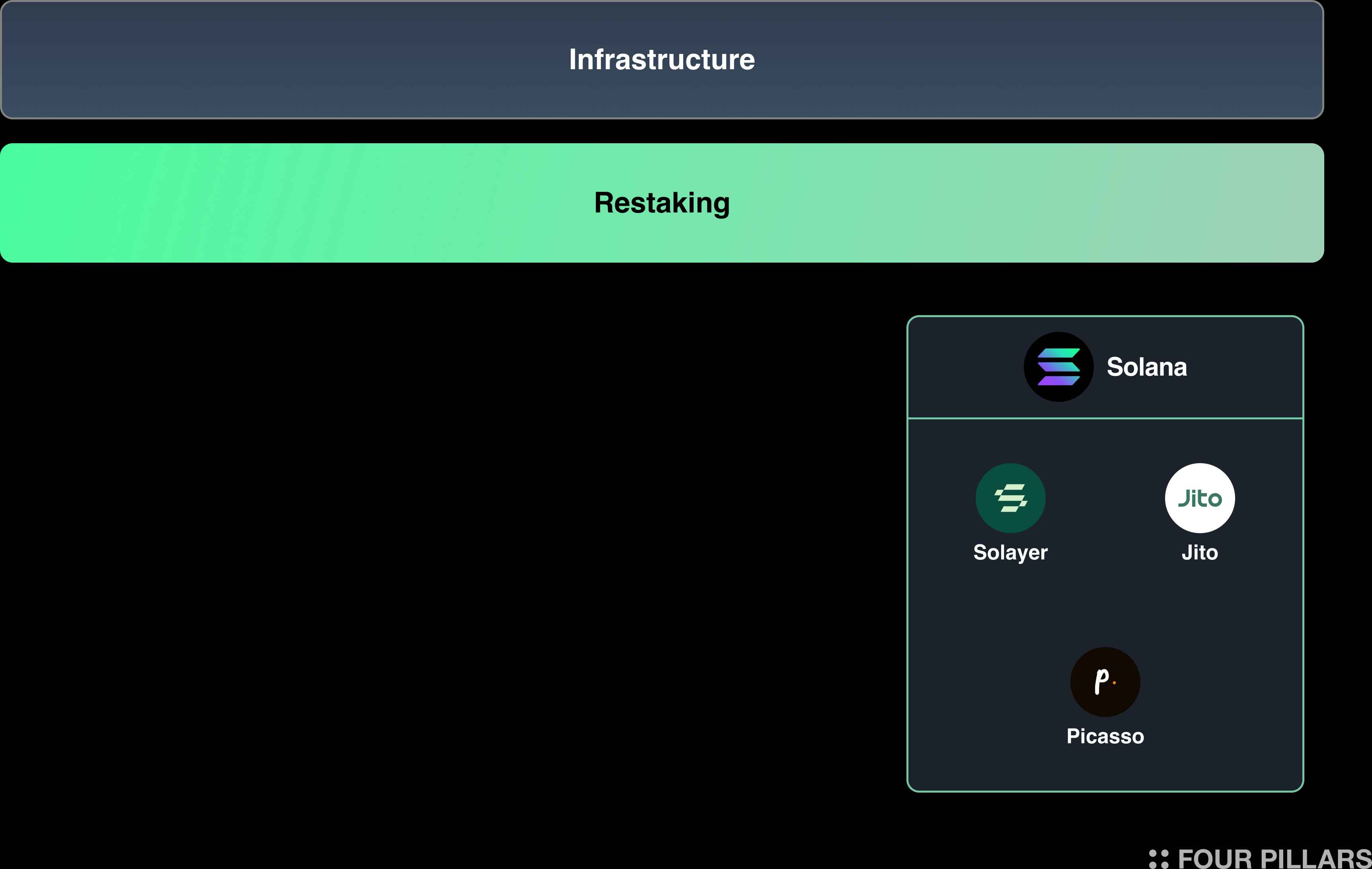
Solana is known for its high transaction throughput and low fees, making it an ideal environment for the development of re-staking infrastructure. Several projects within the Solana ecosystem have adopted re-staking models to fully leverage these advantages.
The rapid growth of Solana has directly benefited validators, but achieving fair distribution of economic gains across the broader Solana ecosystem has been a challenge. Solayer addresses this issue by providing re-staking infrastructure focused on economic security and execution, expanding application chain networks and offering a framework for staking native SOL and LSTs to support specific application networks. It also allows users to repurpose their staked assets in other protocols to maximize returns.
Solayer draws inspiration from Ethereum's re-staking infrastructure (such as EigenLayer), adopting a similar user convenience approach while adjusting its re-staking model to Solana's unique attributes. This ultimately aims to drive the evolution of the Solana ecosystem.
Jito has gained recognition for its role in Solana's staking infrastructure and is working to expand its influence in the re-staking space. Jito is building its re-staking services on its established Solana infrastructure, generating significant interest from users due to its potential scalability and reliability. Jito's vision is to optimize the MEV during the block creation process through re-staking solutions based on SPL assets. This not only enhances security but also provides greater profit opportunities for re-stakers.
Picasso supports Solana's scalability by building a cross-chain expansion framework and re-staking mechanism. Picasso is developing a re-staking layer for Solana as well as the Cosmos ecosystem, introducing the concept of allowing users to re-stake assets across multiple PoS networks. It aims to bring the previously Ethereum-exclusive re-staking ecosystem to Solana and the Inter-Blockchain Communication (IBC) ecosystem, providing tailored re-staking services with grand ambitions.
3.4 Increasing Complexity of Re-staking Infrastructure

A major risk of re-staking is that it is inherently a derivative financial asset rather than a core asset. Some view re-staking as a promising investment opportunity and a new advancement in crypto security, while others see it as a high-risk re-mortgaging model with overly generous returns. Additionally, re-staking infrastructure has yet to undergo extreme market tests like a "crypto winter," raising questions about its potential stability.
If this stability is not proven, re-staking may face criticism due to the inherent risks in its re-mortgaging model. Furthermore, the ecosystem has not yet expanded to the scale economies necessary to establish sustainable business models, which remains a challenge.
Nevertheless, the rapid growth of the re-staking ecosystem, particularly in terms of re-staking infrastructure, is undeniable. The increasingly refined structure of the ecosystem supports this growth momentum. As the ecosystem grows, concerns about profitability may be addressed, and ultimately, re-staking infrastructure will play a key role in the fields of crypto and blockchain security.
The classification and definition of the ecosystem indicate that it is ready to embrace the next stage of development. The emergence of the re-staking stack reflects significant progress made by various projects in developing narratives and products.
Now, as the re-staking infrastructure matures, the focus will shift to re-staking platforms and applications, which will determine whether the re-staking ecosystem can achieve widespread adoption. Therefore, the next part of this series will delve deeper into re-staking platforms and applications, exploring their potential in driving widespread adoption of the ecosystem.
免责声明:本文章仅代表作者个人观点,不代表本平台的立场和观点。本文章仅供信息分享,不构成对任何人的任何投资建议。用户与作者之间的任何争议,与本平台无关。如网页中刊载的文章或图片涉及侵权,请提供相关的权利证明和身份证明发送邮件到support@aicoin.com,本平台相关工作人员将会进行核查。




